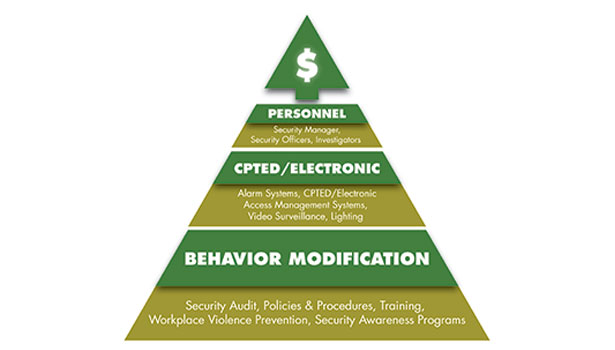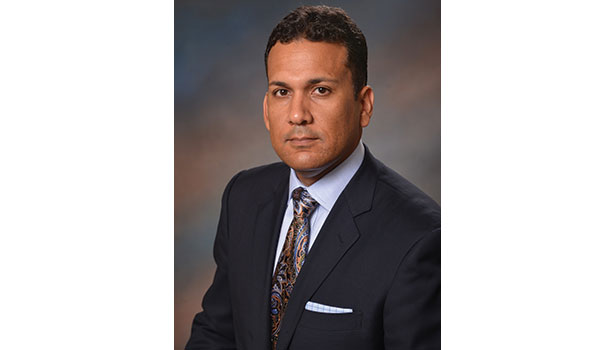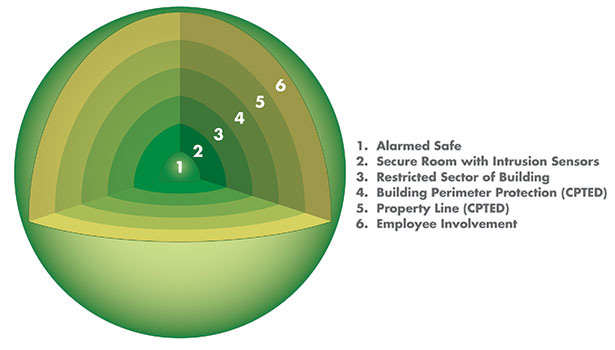Mitigating Workplace Violence Risks with Awareness, Deescalation
Workplace violence incidents happen every day, in every industry, and statistics show reports that these events are on the rise.

A security hierarchy developed by William Nesbitt from Security Management Services International. The idea is to equip a company or business with the bottom layer, which involves the least expensive solutions. Advance to the second and/or third layer only if necessary. The higher up the pyramid, the more costly the solution. Graphic courtesy of William Nesbitt

“You can actually diffuse a situation from exploding just by listening to the person, whether or not it is relevant to what you do (as an employee). A lot of the time, people just want to express themselves, and if you just give them a good ear, that will really calm down the situation,” says J. Kelly Stewart, Managing Principal and CSO of Newcastle Consulting, LLC. Photo courtesy of J. Kelly Stewart

“Be sure employees understand exactly what constitutes workplace violence, and make them aware that it can happen anywhere, at any time,” says Eric Sean Clay, Managing Partner of Clay Krivulka Solutions. Photo courtesy of Eric Sean Clay

The majority of the time, people will give you indicators that they’re about to become physically violent, says Bryan Warren, Director of Corporate Security at Carolinas Healthcare System. Photo courtesy of Bryan Warren

The ideal layers of protection involved in workplace violence security. Graphic courtesy of William Nesbitt





Workplace violence incidents happen every day, in every industry, and statistics show reports that these events are on the rise. As a security professional, what can you do to mitigate the risks of workplace violence so that your customers and employees are safe and your brand is secure? Here, four experts on workplace violence weigh in.
Get an assessment from a professional
Workplace violence incidents can be internal, meaning they are caused by an employee, or external, that is, caused by a customer, client or patient. The potential of each kind depends on the industry. “That’s why we do a vulnerability threat analysis,” says William Nesbitt, President of Security Management Services International, Inc. “The preventive remedies are somewhat different depending on the environment. That’s the purpose of an assessment – to find out what the unique threat models are for that particular location and what kind of reasonable mitigating solutions can be applied.”
Focus on employee education and training
All of the experts interviewed agreed that this element is easily the most important in helping to lessen the impact of workplace violence incidents. “Be sure employees understand exactly what constitutes workplace violence, and make them aware that it can happen anywhere, at any time,” says Eric Sean Clay, Managing Partner of Clay Krivulka Solutions. “In an awful lot of cases I’ve had over the years where bad things have happened, the common factor has been the people involved did not see it coming, partially because they didn’t want to see it coming or because they weren’t trained to see it coming,” Nesbitt says.
Define and understand what constitutes suspicious behavior
At a recent hospital training session, Nesbitt asked multiple groups of employees if they had been trained to look for suspicious behavior. They all said yes, but when asked what suspicious behavior looks like, “no one could articulate that,” Nesbitt says. “It took me all of five minutes to explain what suspicious behavior looks like in terms of body language and eye contact.”
“If someone is doing something that doesn’t look right, employees can generally tell that. They should trust their instincts and report it to security and not place themselves in positions where there is a potential to be a victim,” says Clay. “It’s important to encourage people to report anything that’s out of the ordinary.”
The majority of the time, people will give you indicators that they’re about to become physically violent, says Bryan Warren, Director of Corporate Security at Carolinas Healthcare System. “When someone is turning physically red, their breathing is erratic, they’re flexing their fists, and they’re clenching their jaws, that’s a good indication that fight or flight has kicked in, and you need to be cautious because that person is entering a very dangerous mental state and rationality has left the picture,” Warren says.
“Don’t ask (a suspicious person) if you can help them,” Nesbitt says. “That’s the worst question you can ask because it requires a yes or no answer. Someone could say no and not mean it and you couldn’t tell. Instead, ask what patient or what department they’re looking for. They won’t have a spontaneous answer if they’re there for bad reasons. A lot of those folks that you confront really are lost, and so now you’re just doing good customer service.”
Learn to listen
“You can actually diffuse a situation from exploding just by listening to the person, whether or not it is relevant to what you do (as an employee). A lot of the time, people just want to express themselves and if you just give them a good ear, that will really calm down the situation,” says J. Kelly Stewart, Managing Principal and CSO of Newcastle Consulting, LLC.
Discuss hypothetical scenarios
“I’m a big believer in sitting down with company leadership and going through hypothetical examples and walking through a plan on how we’re going to do this, making sure that all key participants are familiar with procedures and any shortcomings that we might experience. Going through the process and understanding what really goes into it is important,” says Clay.
Know what to do during workplace violence incidents
“Educate the employees on what the reporting responsibilities are, the procedures for informing management that there is potentially an issue, and how security would respond to those issues. Know what you’d do in the situation,” Clay says. Consider implementing emergency management drills so employees become familiar with how to react to a workplace violence event.
Have a solid communications plan in place
“What kind of mass communication tools do you have? How do you inform people of what’s occurring? Communication is one of the main drivers of a safe working atmosphere,” says Stewart. A communications plan could, for example, include a central messaging system. At the Disney resort where Clay previously worked as director of security, “we could send out a text message, an email, or a voice mail to all 1,800+ employees at one time. So if an incident occurred, everyone got the information in real time. It was two-way communication so if, say, someone saw the suspicious person somewhere, it could get back to the security department,” Clay says.
Look at physical safeguards
Depending on the environment you’re in, physical safeguards such as desks, railings and panic buttons can be helpful deterrents. “You don’t want to make it look like a prison, but at the same time, you can make minor modifications that help protect. There are little things you can do that are aesthetically pleasing, but serve a physical security purpose to preventing these potential workplace violence incidents from occurring. I think this is something that could go a long way in actually mitigating some of this (workplace violence) before it begins,” says Warren.
Follow up on reports
“A lot of times things will get reported to security, and it’s important to follow up and follow your instincts. If you’re a manager of a corporation or company and you hear something, it’s important that you follow up on it immediately and try to be proactive and diffuse the situation because a lot of times there’s an opportunity before it escalates to a more significant incident,” says Clay.
Remember that technology is just another tool
Technology has certainly become more cost-efficient and effective over the years, but relying too heavily on it is a mistake. “(The bad guy) has to get by the employee and the system. The system can fail, things go wrong, so we need to do everything we did before the system,” says Nesbitt. Remain alert to suspicious behavior, even if your business is using the best technology available.
“Technology is going to assist you in creating a response plan or a communication plan that’s effective,” says Stewart. “It can certainly slow workplace violence down, and in some instances prevent it from occurring, but if the violence does occur, how will the technology help you get through the incident properly?” More technology doesn’t necessarily equal more safety, so evaluate what you have and how effective it is.
Consider implementing a security management system
“There are security management systems out there now that give you the ability to track incidents and the corrective action that you take as a result. They allow you to do a rather sophisticated analysis of a number of different variables to find trends that you might not have been able to spot in the old days when you wrote a report and filed it in a drawer. This allows you to start looking with more specificity at what kind of corrective action you need to apply to mitigate against whatever that anomaly is and then, after the fact, to measure as to whether the actions you took worked or not,” says Nesbitt.
Look into CPTED (Crime Prevention through Environmental Design)
Nesbitt is a big advocate of using CPTED, which “has to do with how you design properties to give the perception of more security. It’s basically a technique for synergy, a means by which all of the various disparate parts of the security system and program work in some sort of harmony,” he says. Components may include lighting, fencing, external appeal, locks, landscaping and signage. For more information on CPTED, visit www.cptedsecurity.com.
Follow the Security Solutions Hierarchy
Developed and used by Nesbitt, the first level consists of behavior modification solutions, such as policies and procedures, training, security awareness programs, and workplace violence protection. Level one is easily the most cost-effective, and Nesbitt starts here. Then, if further problems occur, he ratchets up to level two, using CPTED and technology, such as alarm systems, cameras and access management systems. The final level is personnel, which means hiring security officers. “My thesis is to apply the least expensive remedies first, then if you still have exposure, go to level two, and if you still have exposure, consider the use of man power,” Nesbitt says. “In the real world, there’s a segment of some security people that hire security officers as a first technique, which is very expensive. There’s a lot that can be done simply by raising the awareness of the employees of the kinds of things that can result in violence in the workplace and to deal with them at the incipient stage.”
Beware of apathy
“I think one of the biggest disservices any company or organization can do is to have the idea that it hasn’t ever happened here and it never will, or it’ll happen to somebody else. Unfortunately, nobody can afford to have that philosophy anymore,” says Warren. “The most dangerous thing I’ve seen from an organizational level is ignorance of the possibility of workplace violence and then apathy to taking measures to try to at least be proactive and prepare for it should it happen.”
Looking for a reprint of this article?
From high-res PDFs to custom plaques, order your copy today!










